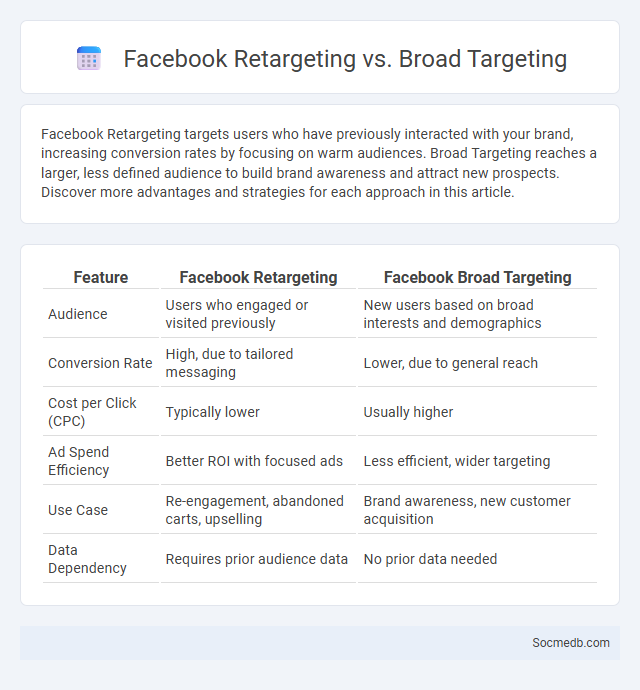
Photo illustration: Facebook Retargeting vs Broad Targeting
Facebook Retargeting targets users who have previously interacted with your brand, increasing conversion rates by focusing on warm audiences. Broad Targeting reaches a larger, less defined audience to build brand awareness and attract new prospects. Discover more advantages and strategies for each approach in this article.
Table of Comparison
| Feature | Facebook Retargeting | Facebook Broad Targeting |
|---|---|---|
| Audience | Users who engaged or visited previously | New users based on broad interests and demographics |
| Conversion Rate | High, due to tailored messaging | Lower, due to general reach |
| Cost per Click (CPC) | Typically lower | Usually higher |
| Ad Spend Efficiency | Better ROI with focused ads | Less efficient, wider targeting |
| Use Case | Re-engagement, abandoned carts, upselling | Brand awareness, new customer acquisition |
| Data Dependency | Requires prior audience data | No prior data needed |
Understanding Facebook Retargeting: An Overview
Facebook retargeting leverages pixel tracking to identify users who previously interacted with your website or app, enabling precise ad delivery based on their past behavior. By creating custom audiences, businesses can re-engage potential customers with tailored content, improving conversion rates and return on ad spend. Advanced targeting options, such as dynamic product ads, further personalize marketing efforts by showing relevant products users viewed but didn't purchase.
Defining Broad Targeting on Facebook
Broad targeting on Facebook involves reaching a wide audience without strict demographic or interest filters, maximizing your ad's visibility. This strategy leverages Facebook's algorithm to optimize delivery by learning who engages most with your content. You can increase brand awareness and gather valuable insights by allowing Facebook to find potential customers beyond narrow segments.
Key Differences: Retargeting vs Broad Targeting
Retargeting on social media focuses on engaging users who have previously interacted with a brand, leveraging pixel data to deliver personalized ads that increase conversion likelihood. Broad targeting casts a wider net by using demographic, interest, and behavioral data to reach new audiences, prioritizing brand awareness and lead generation. Retargeting typically yields higher ROI due to its precise targeting, while broad targeting is essential for expanding market reach and attracting potential customers unfamiliar with the brand.
How Facebook Retargeting Works
Facebook retargeting works by using tracking pixels placed on your website to collect data about visitors' behavior, allowing you to create custom audiences based on their interactions. You can then deliver personalized ads to these users on Facebook, increasing the likelihood of conversion by reminding them of products or services they viewed. This strategy enhances your advertising efficiency by targeting users already interested in your brand, improving return on ad spend (ROAS).
When to Use Retargeting in Facebook Campaigns
Retargeting in Facebook campaigns is most effective when targeting users who have previously interacted with your brand but have not completed a desired action, such as making a purchase or signing up for a newsletter. Implement retargeting after sufficient initial audience engagement data is collected, typically 7 to 14 days post-campaign launch, to maximize ad relevance and conversion rates. Utilize Facebook Pixel data to create custom audiences of website visitors or app users, enhancing the precision and impact of retargeting efforts.
When to Use Broad Targeting for Facebook Ads
Broad targeting for Facebook ads is most effective when You aim to reach a larger, more diverse audience to increase brand awareness or gather data for future campaigns. This approach works well for new products, apps, or services entering the market, where precise demographics are not yet established. Leveraging Facebook's algorithm with broad targeting helps optimize ad delivery based on user behavior and engagement signals.
Pros and Cons: Retargeting vs Broad Targeting
Retargeting on social media delivers high conversion rates by targeting users who have previously interacted with a brand, boosting ROI through personalized ads and improved engagement. Broad targeting expands reach and brand awareness by casting a wider net to diverse audiences, though it may yield lower conversion rates and higher ad spend due to less precise audience alignment. Effective social media campaigns balance retargeting's precision with broad targeting's scalability to optimize budget efficiency and overall marketing impact.
Performance Metrics: Measuring Success for Both Strategies
Performance metrics such as engagement rate, reach, click-through rate (CTR), and conversion rate provide critical insights into the effectiveness of social media strategies. Analyzing these metrics helps optimize content for better audience interaction and improved return on investment (ROI). Tools like Google Analytics and native platform insights enable real-time monitoring and data-driven decision-making to enhance campaign performance.
Common Mistakes in Facebook Targeting and Retargeting
Ineffective Facebook targeting often results from overly broad audience selections that waste budget on uninterested users and neglect of detailed demographic and interest filters critical for precision. Common retargeting mistakes include targeting users who have already converted or setting too narrow time windows, which limits reach and reduces campaign effectiveness. Optimizing your Facebook strategy requires continuous audience segmentation analysis and leveraging Facebook Pixel data to refine target groups for higher engagement and conversion rates.
Choosing the Right Facebook Targeting Strategy for Your Goals
Selecting the right Facebook targeting strategy depends on clearly identifying your campaign goals, whether driving brand awareness, increasing website traffic, or boosting conversions. Utilizing Facebook's detailed targeting options such as custom audiences, lookalike audiences, and interest-based segments ensures precise reach to users most likely to engage with your content. Analyzing performance metrics like click-through rates and conversion rates continuously refines your targeting, maximizing ROI for your social media marketing efforts.
 socmedb.com
socmedb.com